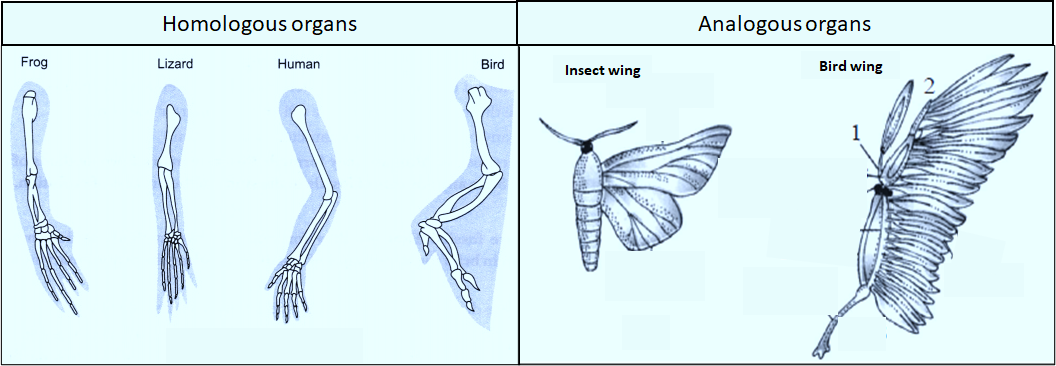
Wing of bat and wing of bird are examples of ________ organs.
(a) Analogous
(b) Homologous
(c) Both A and B
(d) None of the above
Answer
504.3k+ views
Hint: Wing of bat and wing of bird evolved independently but both perform the same function of flying. These structures show convergent evolution and indicate that the organisms are evolutionarily different.
Complete answer:
Bat and bird wings are examples of analogous structures. The wings of the bird are made up of feathers that extend all along the arm. However, the wings of bats consist of flaps of skin that stretch between the bones of the fingers but the wings of both organisms perform the similar function of flying.
All the body organs are classified into two categories based on their evolutionary past: homologous organs and analogous organs.
Homologous Organs: The organs of different animals that have an alike structure but differ in their functions are called homologous organs. The structure of the two different animals mirror but the functions of their organs vary. Examples of such organs are the forelimbs of frog, man, and the flippers of the whale. The structure of these limbs are the same but the function in a different way. The flippers are utilised for swimming, the forelimbs of frogs are utilised for jumping and propping, and the forelimbs of man are utilised for writing, eating, holding things, etc. Having a similar structure reveals that all these animals have a shared ancestor.
Analogous Organs: The organs of different animals that have distinct structure but perform similar functions are called analogous organs. Examples of such organs are the wings of the insect and the wings of the bird. The structure of wings of the bird have bones enclosed by flesh, skin, and feathers. Whereas the wings of an insect is an extension of the skin as a thin membrane. But in both cases, the wings are used for flying. These animals would have to adapt to the same ecological niche as other organisms. Hence, they may have evolved similar organs.

So, the correct answer is “analogous ”.
Note: Both analogous and homologous organs are important from the evolutionary perspective. They help to show how different organisms have evolved from a common ancestor showing divergent radiation. And vice versa in the convergent radiation.
Complete answer:
Bat and bird wings are examples of analogous structures. The wings of the bird are made up of feathers that extend all along the arm. However, the wings of bats consist of flaps of skin that stretch between the bones of the fingers but the wings of both organisms perform the similar function of flying.
All the body organs are classified into two categories based on their evolutionary past: homologous organs and analogous organs.
Homologous Organs: The organs of different animals that have an alike structure but differ in their functions are called homologous organs. The structure of the two different animals mirror but the functions of their organs vary. Examples of such organs are the forelimbs of frog, man, and the flippers of the whale. The structure of these limbs are the same but the function in a different way. The flippers are utilised for swimming, the forelimbs of frogs are utilised for jumping and propping, and the forelimbs of man are utilised for writing, eating, holding things, etc. Having a similar structure reveals that all these animals have a shared ancestor.
Analogous Organs: The organs of different animals that have distinct structure but perform similar functions are called analogous organs. Examples of such organs are the wings of the insect and the wings of the bird. The structure of wings of the bird have bones enclosed by flesh, skin, and feathers. Whereas the wings of an insect is an extension of the skin as a thin membrane. But in both cases, the wings are used for flying. These animals would have to adapt to the same ecological niche as other organisms. Hence, they may have evolved similar organs.

So, the correct answer is “analogous ”.
Note: Both analogous and homologous organs are important from the evolutionary perspective. They help to show how different organisms have evolved from a common ancestor showing divergent radiation. And vice versa in the convergent radiation.
Recently Updated Pages
Master Class 11 Economics: Engaging Questions & Answers for Success

Master Class 11 Business Studies: Engaging Questions & Answers for Success

Master Class 11 Accountancy: Engaging Questions & Answers for Success

Master Class 11 English: Engaging Questions & Answers for Success

Master Class 11 Computer Science: Engaging Questions & Answers for Success

Master Class 11 Maths: Engaging Questions & Answers for Success

Trending doubts
Which one is a true fish A Jellyfish B Starfish C Dogfish class 11 biology CBSE

State and prove Bernoullis theorem class 11 physics CBSE

1 ton equals to A 100 kg B 1000 kg C 10 kg D 10000 class 11 physics CBSE

In which part of the body the blood is purified oxygenation class 11 biology CBSE

One Metric ton is equal to kg A 10000 B 1000 C 100 class 11 physics CBSE

Difference Between Prokaryotic Cells and Eukaryotic Cells




